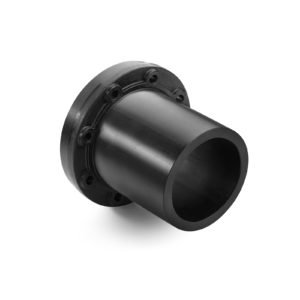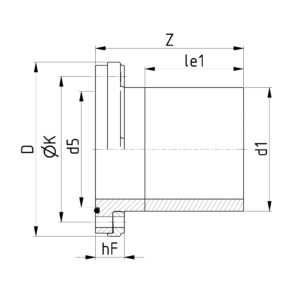VP flanges
The specialist for valve connections and transition to steel/cast flanges
The further development of our special flanges is combined in the VP flange, which is equipped with a corrosion-free, fiber-reinforced plastic backing flange drilled to DIN EN 1092 PN 10. Slotted holes in the collar allow easier assembly and alignment of the flange connection. The spring effect of the flange integrated into the design, which ensures permanent bolt pretensioning, is a particular highlight. Its low weight in particular reduces installation work and project costs.
Tender text
PE100 VP flange (Valve Performance flange)
General preliminary remarks
The fittings to be offered must be supplied as a set consisting of a welding neck and a backing flange adapted to the dimension. The welding neck collars must be made of material in accordance with the PE100+ Association and comply with DIN EN 12201 and DIN EN 1555 in terms of dimensions, tolerances and quality requirements. The backing flanges must be made of corrosion-free, fiber-reinforced plastic. Proof of production on the basis of a quality assurance system in accordance with DIN EN ISO 9001 must be provided. A certificate in accordance with DIN EN 10204 must be provided by the manufacturer for all molded parts. Alternatively, the PE molded part body must be manufactured from a single piece of homogeneous semi-finished product by injection molding. Semi-finished products made from winding rod or other subsequently applied reinforcements are not permitted. The collar must be drilled in accordance with the hole pattern to DIN EN 1092–1 PN 10 or PN 16. The screw holes are therefore closer to the outside diameter of the pipe. The backing flange must have the same hole pattern. This enables the same nominal diameter transition to fittings or steel flanges, for example.
Read more
The collar and flange must engage positively with each other at their connecting surfaces, and the flange must also support the collar from the outside in order to counteract deformation. This ensures that the flange connection can withstand full pressure in accordance with the pipe dimensioning. The backing flange must be equipped with a disc spring function that maintains the preload after tightening the screws. The screw holes in the PE collar must be designed as slotted holes to ensure perfect alignment of the flanges or fittings.The collar must be fitted with an EPDM O‑ring seal appropriate to the dimensions.
The spigot ends must have a long shape in order to be able to carry out both HE butt welding and HW welding.
Optionally available versions: flat sealing without groove and O‑ring.
Standards/guidelines
DIN EN 12201, DIN EN 1092–1, DVS 2207, DVS 2210, DIN EN 10204, DIN EN ISO 9001, DIN EN ISO 50001, DVGW W 400–2, DVGW GW 335Authorisations/certificates
DVGW: DV-8606BT0423 und DV-8611BT0424
Inspection certificate 3.1 according to DIN EN ISO 10204 on the semi-finished product from the processed raw material with indication of MFR and OIT; only PE100 material according to PE100+ Association
Manufacturer certified according to ISO 9001:2015 and ISO 50001:2011
Manufactur:
Reinert-Ritz GmbH or equivalentPerformance description:
PE100 VP flange with backing flange made of corrosion-free, fibre-reinforced plastic for connection to fittings with the same nominal diameter, with pre-tensioning and alignment function, with EPDM O‑ring, designed for full pressure load capacity, drilled to DIN EN 1092–1, with long welding end for HW welding,DN …
d1 …
SDR …
PN …Proof of supply:
Reinert-Ritz GmbH
Ernst-Heinkel-Straße 2
48531 Nordhorn
Tel.: +49 5921 8347–0
Fax: +49 5921 8347–25
www.reinert-ritz.de
Email: contact@reinert-ritz.com











